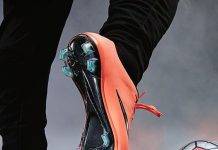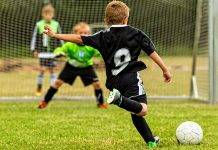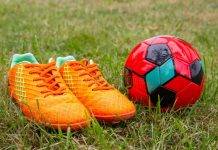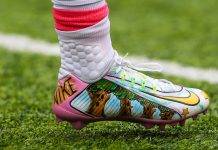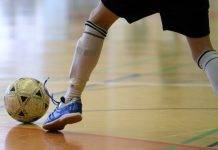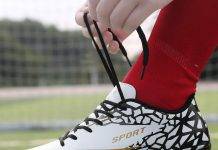Regarding soccer, the choice of footwear can make all the difference. So, are you curious about the distinction between indoor and outdoor soccer cleats?
Many players wonder whether these shoes serve the same purpose or if their design varies.
In this article, we shed light on the defining differences between indoor and outdoor soccer cleats, helping you make an informed decision about which pair suits your playing environment the best.
Whether you’re new to the sport or a seasoned player, understanding this footwear distinction is vital for enhancing your performance on the field.
Materials and Construction
Review contents
Upper Material
The upper material of soccer cleats plays a crucial role in the overall performance and comfort of the shoe. It is typically made of synthetic materials such as synthetic leather or mesh, which provide durability and breathability. Synthetic leather is commonly used because it is lightweight, flexible, and offers reasonable ball control. Mesh, on the other hand, enhances breathability, allowing air to circulate and keeping the feet cool during intense matches.
Outsole Material
The outsole material of soccer cleats determines the traction and grip on different surfaces. For outdoor cleats, the outsole is usually made of rubber or a combination of rubber and plastic. Rubber offers excellent traction on natural grass, providing stability and preventing slips. It is also durable and can withstand harsh conditions. In contrast, indoor soccer cleats have outsoles made of non-marking rubber or gum rubber, designed to provide grip and flexibility on hard indoor surfaces without leaving any marks.
Midsole Material
The midsole of soccer cleats is the layer between the upper and the outsole. It provides cushioning and support to the feet during rigorous movements on the field. Typically, the midsole is made of foam or gel materials that absorb shock and minimize the impact on the player’s joints. The choice of midsole material varies depending on personal preference and playing style. Some players prefer a thicker midsole for added cushioning, while others opt for a thinner midsole for better ground feel.
Studs or Blades
Studs or blades are the protrusions found on the outsole of soccer cleats that enhance grip and stability. Outdoor cleats often feature removable studs to adapt to different field conditions. The length and shape of the studs vary depending on the playing surface. Longer studs are suitable for wet or muddy fields, providing better traction, while shorter studs are ideal for dry or firm surfaces. Indoor soccer cleats, on the other hand, have flat rubber outsoles or small rubber knobs, which provide optimal grip on hard indoor surfaces without damaging them.
Performance Factors
Traction
Traction is one of the most important factors when choosing soccer cleats. The grip provided by the cleats allows players to make quick direction changes and accelerations with confidence. For outdoor cleats, the design and length of the studs are crucial in providing traction on natural grass. The pattern and placement of the studs should be optimized for the specific playing conditions. On the other hand, indoor cleats focus on providing grip on hard indoor surfaces, with outsoles designed to maximize surface contact for better maneuverability.
Durability
Durability is another factor to consider when selecting soccer cleats. The shoes need to withstand the demands of rigorous play and various field conditions. Outdoor cleats often have more robust construction and materials, such as reinforced stitching and thicker upper materials, to withstand the wear and tear of natural grass and harsh weather conditions. Indoor cleats, while not subjected to outdoor elements, still need to be durable enough to handle the rigors of indoor play, including hard impacts and frequent lateral movements.
Grip on Different Surfaces
Different playing surfaces require different types of cleats to ensure optimal performance. Outdoor cleats with suitable stud patterns provide excellent grip on natural grass, preventing slips and enhancing stability. The length and shape of the studs can be adjusted for various field conditions, such as wet or dry grass. Indoor cleats, on the other hand, have outsoles designed explicitly for hard indoor surfaces, offering the necessary grip without leaving marks or damaging the floor. Flexibility is also a key feature of indoor cleat outsoles to enhance maneuverability on indoor surfaces.
Comfort
Comfort plays a vital role in a player’s performance on the field. Soccer cleats should provide a snug yet comfortable fit for natural foot movement and prevent discomfort or blisters. The upper material should be flexible enough to mold to the foot’s shape while providing support and stability. Proper cushioning in the midsole is essential to absorb shock and reduce the risk of impact-related injuries. Additionally, padded collars and tongues enhance overall comfort, allowing players to focus on their game without distractions.
Support
Support is crucial to prevent injuries and provide stability during intense gameplay. Soccer cleats should offer sufficient support for the ankles and arches to minimize the risk of twisting or rolling. Features like high-top designs or built-in ankle braces can provide ankle support. Arch support is typically incorporated into the insole or midsole of the cleats. Proper support ensures players can confidently make quick movements, cuts, and turns without compromising stability or risking injury.
Playing Surface
Hard Indoor Surfaces
Specific cleats designed for these surfaces are necessary when playing on indoor surfaces such as wood or synthetic gym floors. Indoor soccer cleats have flat rubber outsoles or small rubber knobs that provide optimal grip and prevent slipping on these hard surfaces. The materials used in indoor cleats are also geared towards indoor play, with features like non-marking rubber to prevent scuffing or damaging the court. The design of indoor cleats emphasizes flexibility and maneuverability, allowing players to make quick movements without compromising traction or stability.
Artificial Turf
Artificial turf, synthetic grass, or AstroTurf, has become increasingly popular in soccer fields. Cleats for artificial turf have unique features to adapt to this playing surface. The outsoles of these cleats usually have shorter, more numerous, and evenly distributed studs to provide optimal grip and prevent excessive penetration into the turf. The upper materials are often reinforced to withstand the abrasive nature of artificial turf and offer durability. Cleats designed for artificial turf ensure players maintain traction, stability, and comfort on these surfaces.
Natural Grass
Natural grass is the traditional playing surface for outdoor soccer. Cleats designed for natural grass have longer studs, typically metal or plastic, to provide excellent traction and grip on the field. The length and shape of the studs can vary depending on field conditions such as wetness or firmness. The upper materials of outdoor cleats are typically more durable and resistant to wear and tear. The design of these cleats focuses on stability and support on uneven natural grass surfaces. Cleats for natural grass ensure players can effectively navigate the field and maintain stability during play.
Design and Features
Weight and Flexibility
The weight and flexibility of soccer cleats directly impact a player’s performance on the field. Lighter cleats allow for faster movements, agility, and acceleration. They enable players to change direction quickly and reduce fatigue during matches. Flexible cleats provide a better ground feel and natural foot movement, allowing players to execute precise actions. However, it is essential to balance weight and support to ensure players have adequate stability and protection while maintaining optimum performance.
Breathability
Breathability is crucial in soccer cleats as it helps keep the feet cool and dry during intense matches. Mesh materials or perforations in the upper allow for proper air circulation, preventing excessive sweating and discomfort. Breathable cleats reduce the risk of blisters and fungal infections by keeping the feet dry and comfortable throughout the game. Players can focus on their performance without being distracted by overheating or moisture buildup.
Padding and Protection
Padding and protection in soccer cleats provide extra comfort and safeguard against impacts and injuries. Cleats with strategically placed padding, such as cushioned collars and tongue, offer enhanced comfort during long hours of play. The padding also helps protect vulnerable areas, such as the ankles or metatarsals, from impacts or collisions with other players. Reinforced toe caps or heel cups add extra protection, minimizing the risk of injuries from accidental kicks or falls.
Closure System
The closure system of soccer cleats contributes to the overall fit and support of the shoes. Traditional lace-up closures allow for a customizable fit, allowing players to adjust the tightness according to their preference. Some cleats feature asymmetrical lacing systems that provide a larger striking surface for better ball control. Alternatively, some cleats utilize innovative closure systems such as Velcro straps or elastic bands, offering quick and secure fastening without tying laces. The closure system should provide a secure, comfortable fit that minimizes slipping and enhances overall performance.
Cost and Availability
Price Range
The cost of soccer cleats can vary greatly depending on the brand, materials used, and added features. High-end cleats made from premium materials and innovative technologies tend to have a higher price tag. However, budget-friendly options are also available without compromising performance or durability. The price range for soccer cleats can range from around $30 for entry-level models to over $200 for top-of-the-line professional-grade cleats. It is essential to consider personal needs, budget, and the level of play when selecting soccer cleats.
Availability
Soccer cleats are widely available in sports stores, online retailers, and even specific soccer specialty stores. Major brands such as Nike, Adidas, and Puma offer a wide range of soccer cleats, catering to different playing styles, surfaces, and budgets. It is essential to ensure proper fit and comfort when purchasing cleats, so trying them on in-store or utilizing online size charts and customer reviews can be helpful. Additionally, availability may vary depending on the region and accessibility to soccer-specific stores or sports retailers.
Specialized Models
Specialized models of soccer cleats cater to specific playing styles or positions on the field. For example, cleats are designed for forwards that prioritize agility and speed, with features such as lightweight materials and innovative stud designs for quick acceleration.
Goalkeeper-specific cleats often have additional padding and protection to withstand impacts during dives and shots. Midfielder or defender cleats may focus on durability and stability for frequent tackles and changes in direction. Specialized models allow players to find cleats that align with their specific needs and enhance their performance on the field.
Care and Maintenance
Cleaning
Proper cleaning of soccer cleats is essential to maintain their performance and prolong their lifespan. After each use, removing excess dirt or mud with a soft brush or cloth is recommended. A mild detergent or specialized shoe cleaner can be used with warm water for more thorough cleaning. It is important to avoid soaking the cleats or using harsh chemicals that may damage the materials. After cleaning, allow the cleats to air dry naturally, away from direct sunlight or heat sources.
Drying
Proper drying is crucial to prevent bacteria or mold growth inside the cleats. After cleaning, stuff the cleats with newspaper or specialized shoe inserts to absorb moisture and help maintain their shape. Avoid using a dryer or exposing the cleats to direct sunlight, as excessive heat can damage the materials. Allow the cleats to dry naturally in a well-ventilated area, ensuring proper airflow to facilitate drying.
Storage
Storing soccer cleats properly is essential to maintain their shape and prevent damage. After each use, clean the cleats and ensure they are scorched before storing them. Store the cleats in a cool, dry place away from direct sunlight or extreme temperatures.
Using a shoe bag or separate compartment is recommended to prevent them from getting crushed or damaged by other items. Regularly inspect the cleats for wear or damage and replace them if necessary to ensure optimum performance and safety.



